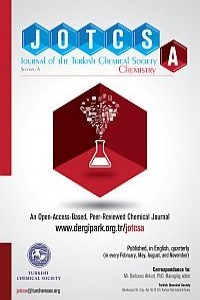Electrochemical Decolorization of Reactive Violet 5 Textile Dye using Pt/Ir Electrodes
Electrochemical decolorization of textile dyeing wastewater containing Reactive Violet 5 (RV5) were investigated at Pt/Ir electrodes in the presence of 75%NaCl+25%Na2CO3 (w/w) supporting electrolyte mixture in a batch electrochemical reactor. Experimental parameters were operated in the range of 300-1500 mg/L textile dye concentration, 4-20 g/L 75%NaCl+25%Na2CO3 electrolyte concentration, 5-15 mA/cm2 current density, and 20-60°C reaction temperature in 15 min electrolysis time. Reactive Violet 5 decolorization increased with increasing current density and electrolyte concentration, and decreasing the textile dye concentration. Although a slight increase obtained in color removal efficiency, the temperature was not show much significant effect on decolorization. Depending on electrochemical reaction conditions, Reactive Violet 5 textile dye decolorization were obtained between 42.8-100%.
___
- Körbahti BK, Tanyolaç A. Electrochemical treatment of simulated textile wastewater with industrial components and Levafix Blue CA reactive dye: Optimization through response surface methodology. Journal of Hazardous Materials. 2008;151(2-3):422–31. DOI: 10.1016/j.jhazmat.2007.06.010.
- US EPA. EPA Office of Compliance Sector Notebook Project : Profile of the Textile Industry. 1997. EPA310R97009.
- US EPA. Best Management Practices for Pollution Prevention in the Textile Industry. 1996. EPA625R96004.
- Körbahti BK. Response surface optimization of electrochemical treatment of textile dye wastewater. Journal of Hazardous Materials. 2007;145(1-2):277–86. DOI: 10.1016/j.jhazmat.2006.11.031.
- Brillas E, Martínez-Huitle CA. Decontamination of wastewaters containing synthetic organic dyes by electrochemical methods. An updated review. Applied Catalysis B: Environmental. 2015. p. 603–43. DOI: 10.1016/j.apcatb.2014.11.016.
- Comninellis C, Chen G. Electrochemistry for the environment. Springer; 2010. ISBN: 9780387369228.
- Körbahti BK, Artut K. Electrochemical oil/water demulsification and purification of bilge water using Pt/Ir electrodes. Desalination. 2010;258(1-3):219–28. DOI: 10.1016/j.desal.2010.03.008.
- Körbahti BK, Taşyürek S. Electrochemical oxidation of ampicillin antibiotic at boron-doped diamond electrodes and process optimization using response surface methodology. Environmental Science and Pollution Research. 2015;22(5):3265–78. DOI: 10.1007/s11356-014-3101-7.
- Panizza M, Cerisola G. Direct And Mediated Anodic Oxidation of Organic Pollutants. Chemical Reviews. 2009;109(12):6541–69. DOI: 10.1021/cr9001319.
- Tarr MA. Chemical Degradation Methods for Wastes and Pollutants. CRC Press; 2003. ISBN: 9780824743079.
- Rajeshwar K, Ibanez JG. Environmental Electrochemistry. Academic Press; 1997. ISBN: 9780123887320.
- Vlyssides AG, Israilides CJ, Loizidou M, Karvouni G, Mourafeti V. Electrochemical treatment of vinasse from beet molasses. Water Science and Technology. 1997;36(2-3):271–8. DOI: 10.1016/S0273-1223(97)00398-3.
- Israilides C, Vlyssides A, Mourafeti V, Karvouni G. Olive oil wastewater treatment with the use of an electrolysis system. Bioresource Technology. 1997;61(2):163–70. DOI: 10.1016/S0960-8524(97)00023-0.
- Do J-S, Yeh W-C. Paired electrooxidative degradation of phenol with in situ electrogenerated hydrogen peroxide and hypochlorite. Journal of Applied Electrochemistry. 1996;26(6):673–8. DOI: 10.1007/BF00253467.
- Lin SH, Shyu CT, Sun MC. Saline wastewater treatment by electrochemical method. Water Research. 1998;32(4):1059–66. DOI: 10.1016/S0043-1354(97)00327-8.
- Tchobanoglous G, Burton FL, Stensel HD. Wastewater Engineering: Treatment and Reuse. McGraw-Hill, 2004. ISBN: 9780071241403.
- Shen ZM, Wu D, Yang J, Yuan T, Wang WH, Jia JP. Methods to improve electrochemical treatment effect of dye wastewater. Journal of Hazardous Materials. 2006;131(1-3):90–7. DOI: 10.1016/j.jhazmat.2005.09.010.
- Başlangıç: 2014
- Yayıncı: Türkiye Kimya Derneği
Sayıdaki Diğer Makaleler
Ruken Esra DEMİRDÖĞEN, Fatih Mehmet EMEN, Derya KİLİC, Gokturk AVSAR, Tuncay YESİLKAYNAK, Tunay ASKAR
Didem BALUN KAYAN, Merve İLHAN, Derya KOÇAK
Demet DEMİRCİ GÜLTEKİN, Azize ALAYLI GÜNGÖR, Hicran ÖNEM, Aynur BABAGİL, Hayrünnisa NADAROĞLU
Nimet Bölgen, Didem Demir, Fatma Öfkeli, Seda Ceylan
DETERMINATION OF BISPHENOL A IN THERMAL PAPER RECEIPTS
Mustafa Serkan YALÇIN, Cihan GEÇGEL, Dilek BATTAL
Bahadır K. Körbahti, Kezban Meltem Turan
Döne Aslı GÜLER, Ali AYDIN, Mesut KOYUNCU, İskender PARMAKSIZ
Özlem Gürsoy Kol, Haydar Yüksek, Sevda Manap, Feyzi Sinan Tokalı
